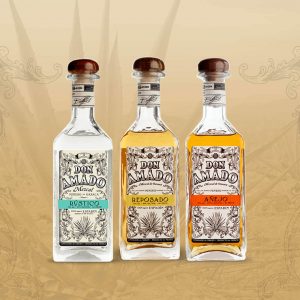 An Incredible Elixir
An Incredible Elixir
By Eric Lawlor, Published in Saveur on May 8, 2002
Until the end of the last century, Alberto Sánchez López tells me over chiles rellenos de picadillo at the excellent El Topil restaurant in the city of Oaxaca, mezcal was the libation of choice for Mexico’s upper crust. They prized this complexly flavored spirit—distilled from the juice of the agave plant, (which the Oaxacans usually call the maguey)—every bit as highly, he adds, as we prize cognac today.
With the appearance of tequila—in effect a regional mezcal, from the state of Jalisco—in the 1890s, and with the concurrent rise in popularity of other alcoholic beverages, however, mezcal began to be eclipsed. From the beginning, tequila producers employed factory methods, distilling their spirit in bulk. Mezcal, on the other hand, was labor-intensive and made in small quantities in tiny village distilleries known as palenques—and it proved no match commercially for its more aggressively marketed counterpart. But that wasn’t the only problem. Inspired by the success of tequila, bottlers in Mexico City started buying up mezcal and adulterating it with sugarcane alcohol. This kind of mezcal is largely responsible for the tawdry image the spirit has today—for its association (at least on the part of many Americans) with, for instance, bar-hopping frat boys or sailors on Cinderella liberty.
Alberto Sánchez López—an industrial engineer employed by Mexico’s Consejo Nacional de Ciencia y Tecnología, and one of the country’s leading experts on mezcal—is among those who are trying to change this debased conception of this spirit. Already there are encouraging signs: About 4.5 million liters of mezcal—half of Mexico’s annual production—come out of 160 small palenques in rural Oaxaca state. In 1994 the Mexican government, after much prodding by Sánchez and others, granted the region the nation’s principal denominación de origen for mezcal. “Mezcal de Oaxaca” means precisely that: mezcal grown, distilled, and bottled in Oaxaca state.
The government also established quality standards: The word mezcal may now be used only to describe a product made from agave, and a mezcal may be described as 100 percent agave only if agave and nothing else is used in its manufacture. Sánchez considers these new standards a welcome improvement—but he is still not satisfied. His goal, he says, is to see inferior mezcal banished from the marketplace altogether.
In the meantime, Sánchez and other supporters of true mezcal also draw encouragement from the fact that several premium mezcals are now being marketed (at cognac-like prices) in the U.S.: Encantado, imported by two Californians, publicist Pam Hunter and vintner Carl Dou-mani; Don Amado, brought in by Jake Lustig, another Californian; and four village-designated mezcals being sold by Del Maguey, a company headed by New Mexico–based artist Ron Cooper. Cooper was introduced to first-rate mezcal on a visit to Oaxaca in 1990, he reports, and couldn’t believe his luck. “I had discovered,” he says, “an incredible elixir.”
Oaxacans talk about Alberto Sánchez López with such respect that I had imagined him some ancient sage, frail and stooped, with flowing white Bertrand Russell locks. Instead, he turned out to be a vigorous, genial man in his early forties who speaks of mezcal with reverence. Mezcal epitomizes artisanship, he believes, adding that he would rather drink three small glasses of it than a whole bottle of tequila. Tequila makers, he tells me, “use high technology just for the sake of it. The mezcal producers haven’t lost the human part—which is the animal part.” According to Sánchez, the finest mezcals are produced using the most primitive, least invasive methods. “The flavors are very delicate,” he explains. “Process them too much and they disappear.”
A Oaxacan proverb suggests, Para todo mal, mezcal, y para todo bien tambien (loosely, mezcal is what you drink when you suffer a setback, and also when you want to celebrate). But mezcal, warns Sánchez, must be respected. It shouldn’t be drunk to excess, he says, and it mustn’t be consumed too quickly. Rhythm is important. Find that rhythm, he claims, and you’ll never get a cruda—a hangover. With good mezcal, Sánchez says, you don’t need salt or lime—and you don’t need that notorious “worm” in the bottom of the bottle. Actually, the gusano, as it’s called, isn’t a worm at all, but a caterpillar supposedly taken from the maguey plant. It is said to have acquired the plant’s supposed magical powers, which are then transmitted to anyone who swallows it. Mezcal, Sánchez adds, is also an aphrodisiac—though when I press him to elaborate, his decorum prevents him from going into details.
I visit a palenque in San Juan del Río, a small village about a hundred miles southwest of the city of Oaxaca (itself the capital of Oaxaca state), with Javier Toledo Flores, a food scientist with a PhD from Cornell University, now employed by Instituto Tecnológico de Oaxaca. San Juan is surrounded by low, green hills along whose sides maguey plants grow in long, lateral lines. The maguey plant—which is not a cactus, but a member of the aloe family—takes as long as 12 years to mature. When it does, it produces a tall floral shoot. Six months before the plant is to be harvested for mezcal, the shoot is removed, causing the juice to accumulate in the plant’s base, or “heart”—which looks like a gigantic pineapple, and is in fact called a piña, pineapple in Spanish. When the heart fills with juice, it swells, sometimes tipping the scales at 120 pounds.
Plants are being harvested on a hilltop as we arrive. Men with hatchets are hacking away at the roots and then kicking the hearts to force them out of the ground. Next, they will chop off the leaves and roll the hearts downhill, where they will be collected, placed on the backs of burros, or small donkeys, and taken to San Juan’s palenque.
San Juan del Río gives the impression of being a relatively prosperous town. Thanks to income from mezcal (and to remittances from locals living in the U.S.), the hundred or so houses here are made of brick and cinder block rather than the more common adobe, and San Juan boasts a large, if not exactly beautiful, church. Mango, banana, and citrus trees line the river, where several women, speaking Sierra Zapotec, are washing bed linens as we pass. Cockerels strut along a main street so narrow that our departure is delayed because it proves almost impossible to turn the car around.
San Juan’s palenque, housed in an open shed backed by a stone wall a few feet above the river, produces about 1,200 liters of mezcal a month—an average amount for these little distilleries. The manufacture of mezcal has changed little since the 1520s, when the Spanish introduced the still to Mexico. San Juan’smezcaleros, as distillery workers are called, place burning charcoal in the horno—a five-foot-deep, stone-lined cooking pit—and fill it with maguey hearts until they form a mound. Then the mezcaleros cover the pit and let the maguey roast for three days, during which time the juice in the hearts acquires a rich, smoky, caramelized flavor. When the hearts are removed from the horno, they’re left to sit, covered with woven mats, for several days in the sun—acquiring, in the process, a green patina indicating that they’re beginning to ferment. They’re next transferred to a shallow cistern, and ground to a pulp by a horse-drawn millstone. After being placed in tinas, or large vats, the pulp is left to ferment for 8 to 15 days. Finally, the fermented juice is distilled twice, in a copper (or sometimes ceramic) still placed over a wood fire. Like most mezcaleros, those in San Juan can tell you the alcoholic content of their mezcal simply by examining the bubbles it produces when the spirit is sucked into a bamboo reed and released into a bowl. The more bubbles and the longer they last, the higher the alcohol content. But if the level is very high or very low, there are no bubbles at all.
Over a delicious lunch of cilantro-spiked chicken soup and freshly made tortillas at a mezcalero’s home in San Juan, we chat with Valeriano Martínez Orozco, a grave, white-haired man who heads ARIC—the Asociación Rural de Interés Colectivo Regional de Productores de Maguey Mezcalero de Oaxaca—a cooperative representing 2,500 agave cultivators and over 150 palenques. In Oaxaca, he explains, making mezcal is a cottage industry; some 25,000 families in the state derive most or all of their living either from growing maguey or from distilling mezcal. According to Martinez, the mezcaleros and the bottlers are not on the best of terms. “It is not the small producers who are the problem,” he says, echoing Sánchez. “It’s the bottlers. They are doing the adulteration. They are the ones without the scruples.” Toledo agrees. “You can take 1,000 liters from your palenque,” he says, “and produce 5,000 liters in a bottling plant.” Martinez views the new quality standards with guarded optimism. Yes, he says, they should put more power in the hands of small producers. But, he adds, “The industry is like a hammock. There’s no telling how it will swing.”
When Ron Cooper discovered first-rate mezcal in 1990, he recalls, he loaded his truck with several gallons of the stuff to bring back to New Mexico. But Customs refused to let him bring in more than a liter of it, and he ended up leaving most of his mezcal in Chihuahua. It was then that he decided to import it commercially. “This is how Del Maguey was born,” he explains. Cooper’s four mezcals come in bottles adorned with labels designed by a well-known Los Angeles–based artist, Ken Price, and packaged in distinctive palm-fiber baskets typical of Oaxaca. Cooper says, “Mezcal is like wine. Because growing and distilling conditions differ from village to village, the mezcals are going to differ, too.” Thus, his San Luís del Río mezcal is spicy, with a hint of citrus; the Minero is more floral, again with faint citrus character; Faustino García Vasquez’s Chichicapa is very citrusy, with a suggestion of mint; and the Santo Domingo Albarradas is spicy, with wood overtones. Cooper claims that his Del Maguey mezcals are the purest examples of this spirit in the world. “I use no chemicals, no colorings, no additives,” he promises.
Don Amado mezcal, produced and imported by the Oakland-based Reunion Mezcal Company, is unusual in that it is distilled in an old-fashioned ceramic still and packaged in handblown glass bottles. Even more unusual, the maguey hearts it uses are steamed after roasting. I suggest to Reunion president Jake Lustig that this isn’t likely to sit well with mezcal purists. On the contrary, he replies. “Don Amado is selling well in Mexico.” Nonetheless, he admits that his mezcal is designed specifically for the American palate, and that steaming yields a mezcal that is smoother and less smoky than more traditional ones. “It doesn’t blast people’s sensations out,” he says.
Encantado—the name means “enchanted” or “bewitched” in Spanish—is not a single-village mezcal, but a blend drawn from 22 different palenques, and redistilled after blending for added smoothness. Herbaceous and floral, Encantado is derived from a recipe devised by Carl Dou-mani—who ran Napa Valley’s acclaimed Stags’ Leap Winery for decades, and now has the new, small Quixote Winery nearby (as well as an interest in Oregon’s Benton Lane Winery). Doumani says that he and some associates spent several years testing blends before deciding on this one. “Most mezcals are smoky,” he says. “I was looking for something more floral.” He believes that a great mezcal should have an earthy quality, “plus this kind of explosion of floral-fruit flavor in the back of your mouth”. He makes it sound as good as, well, cognac.
Read the article on Savuer: An Incredible Elixir

